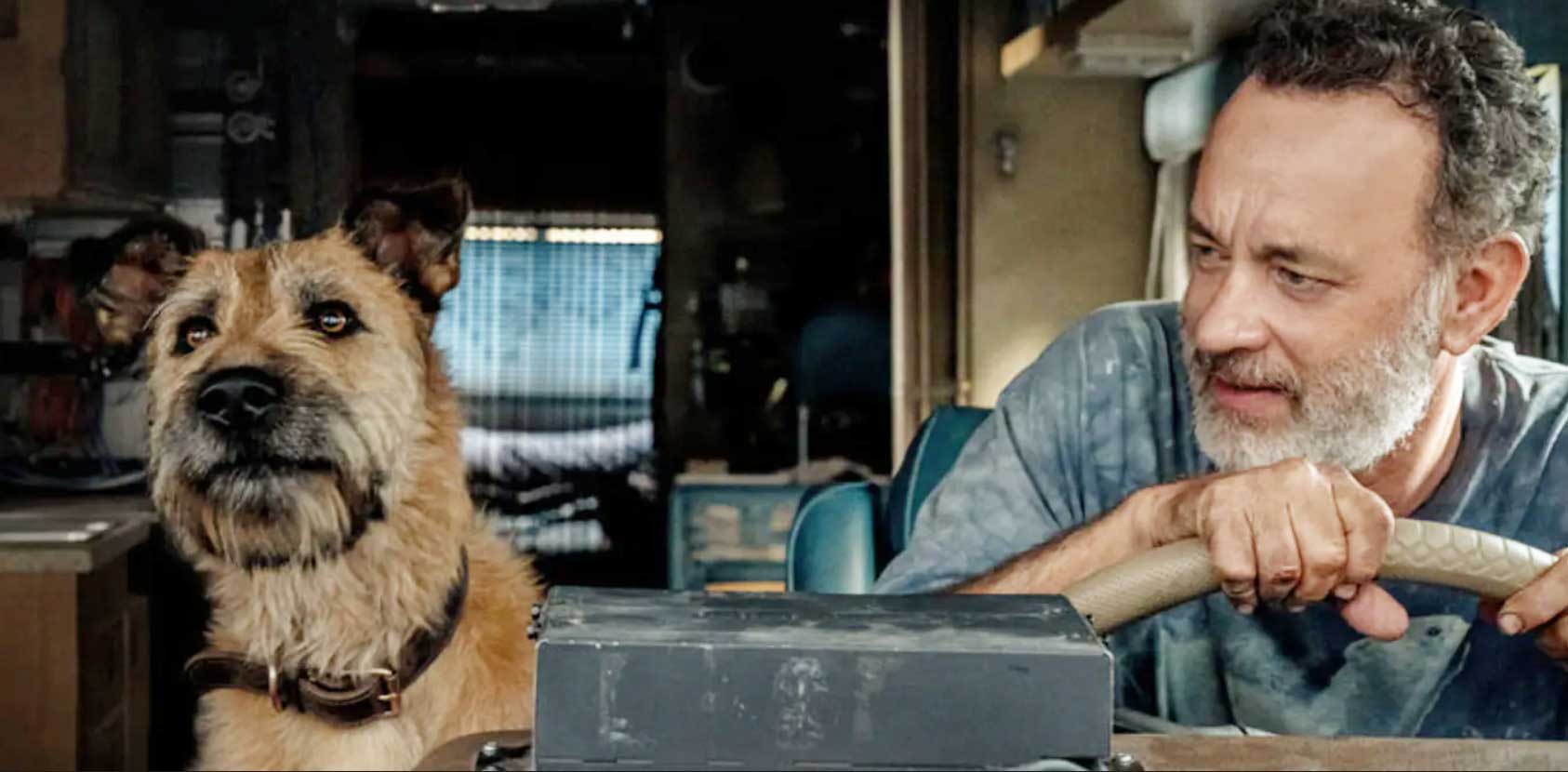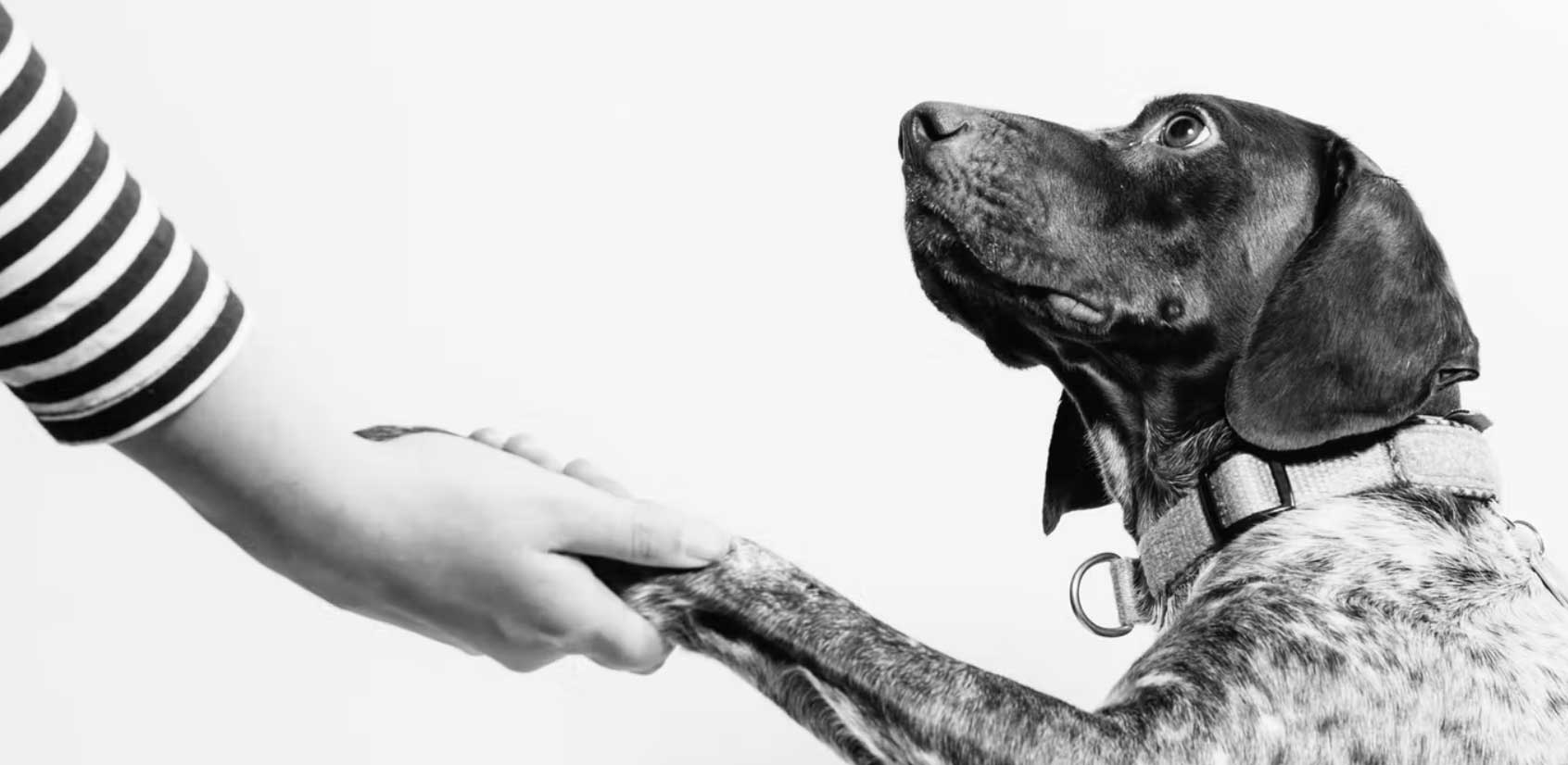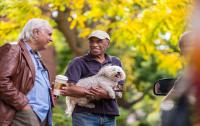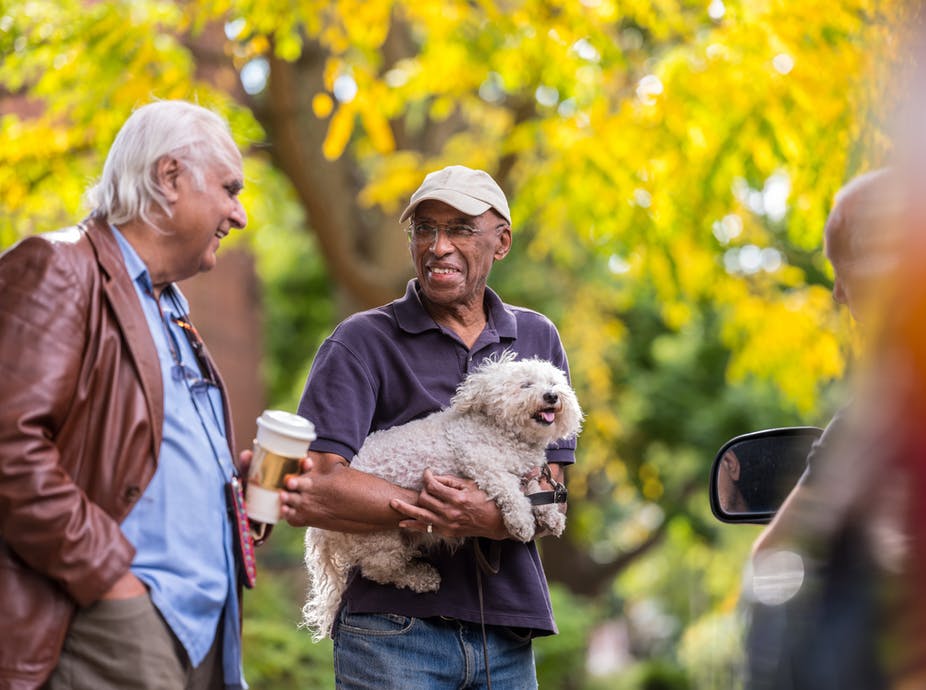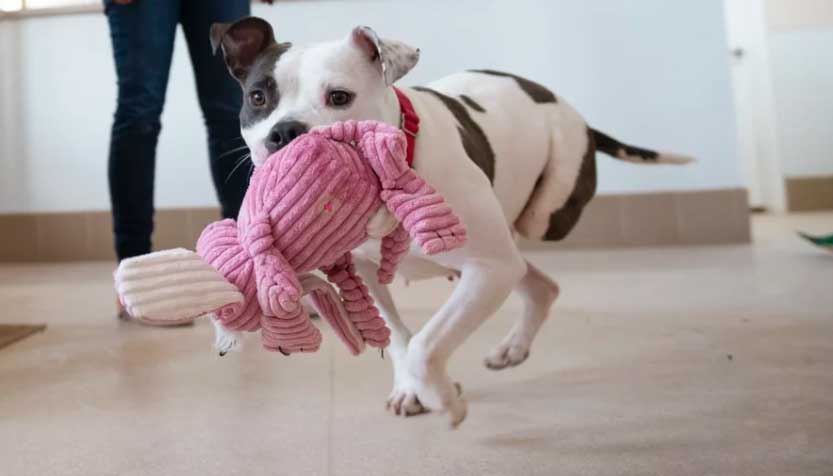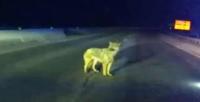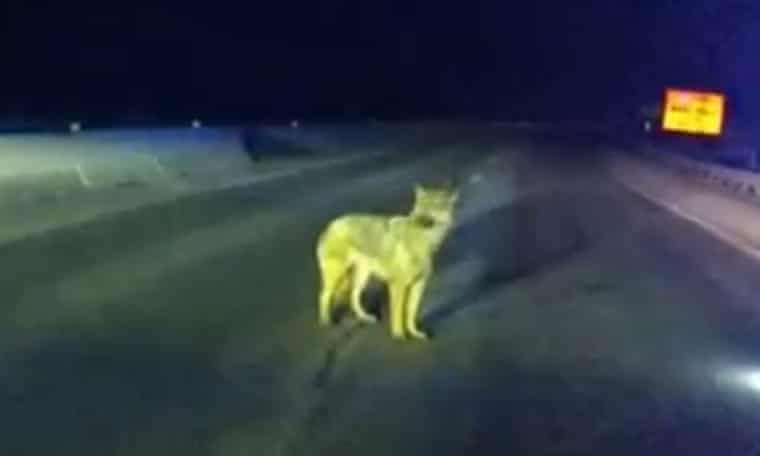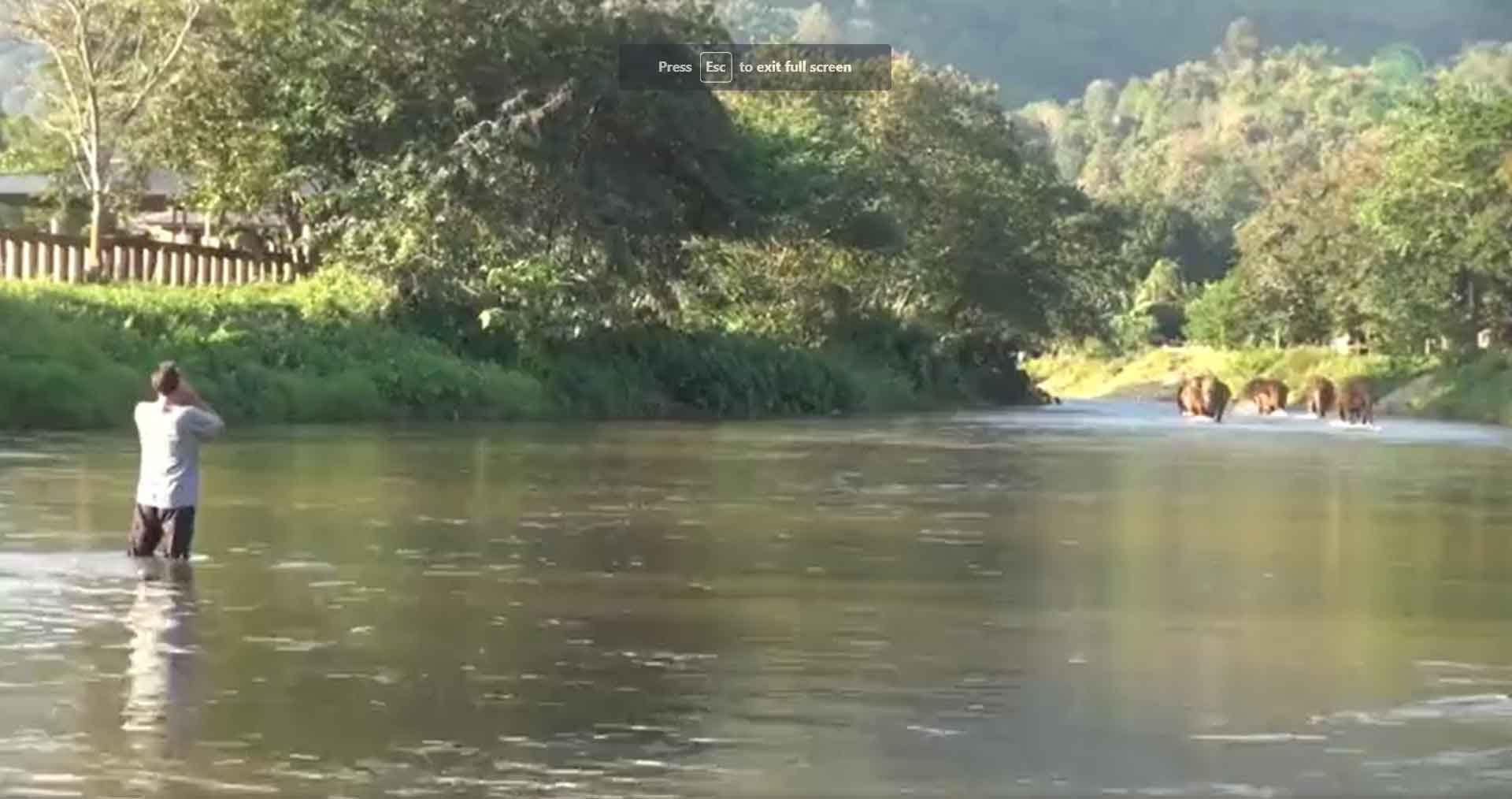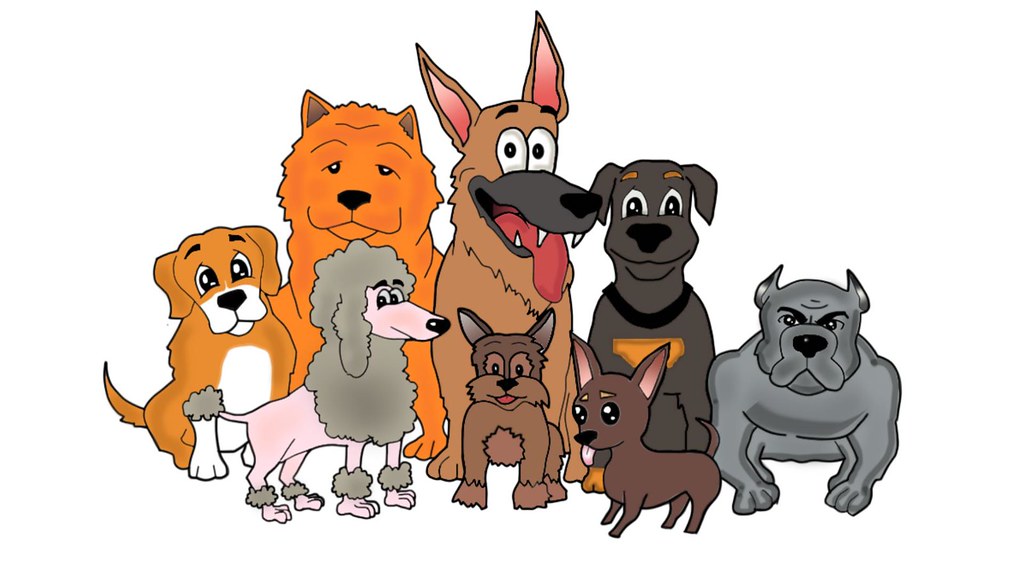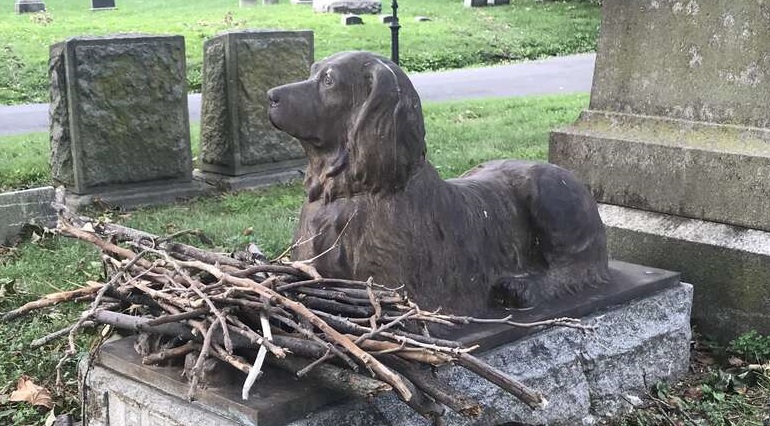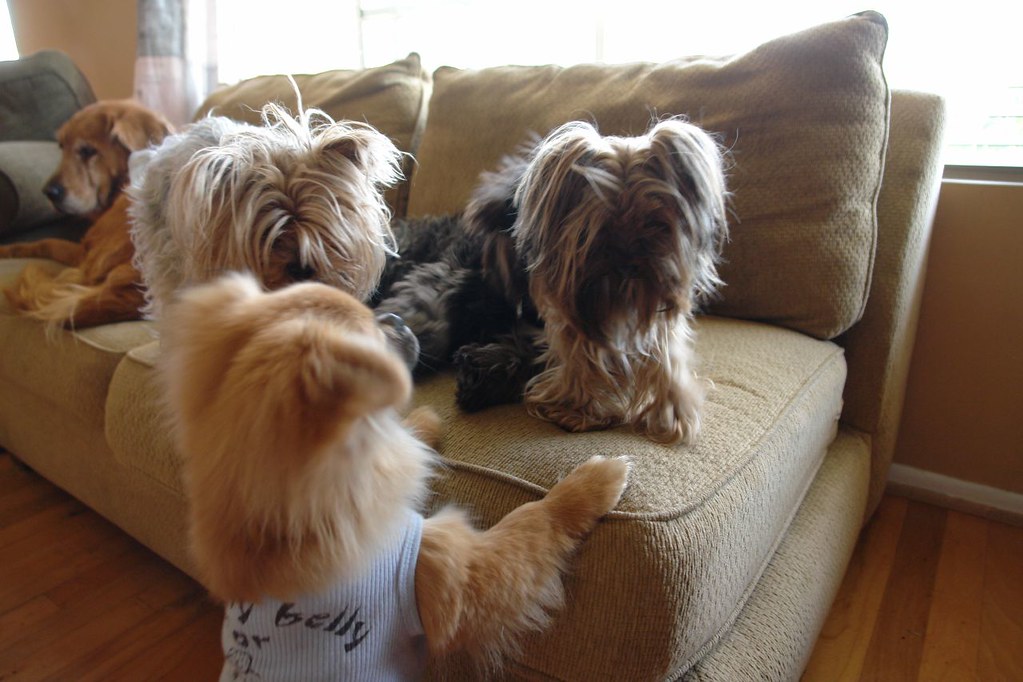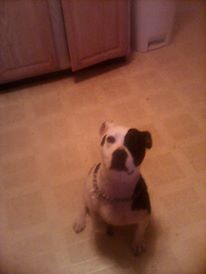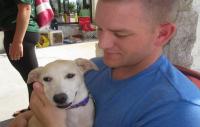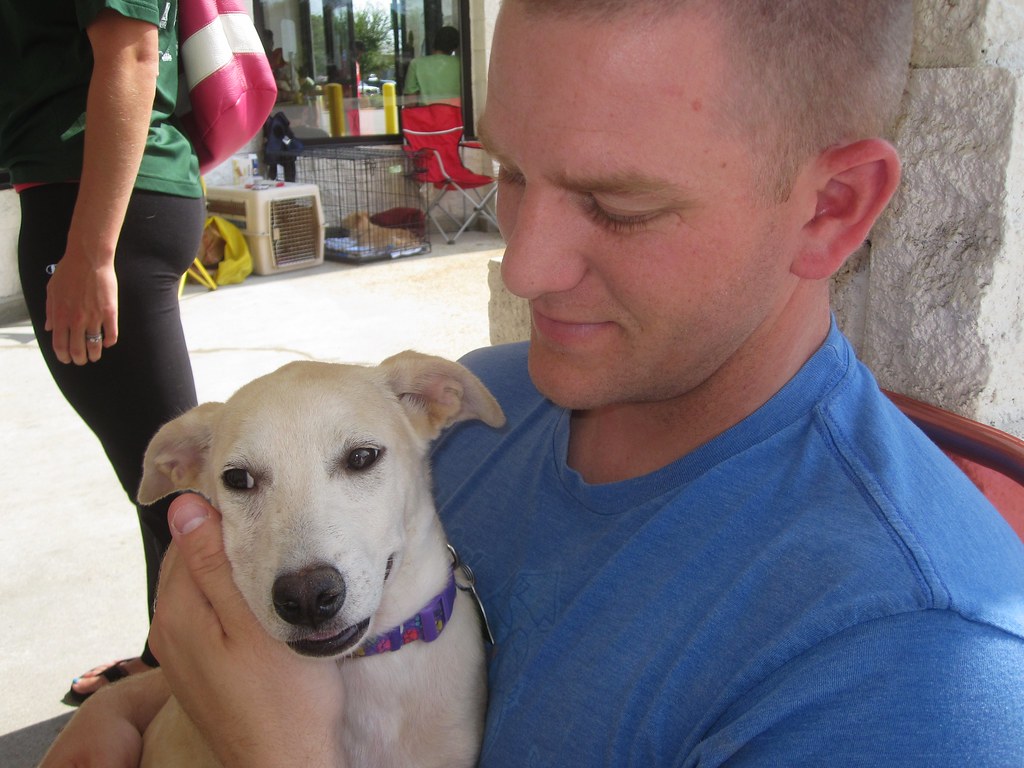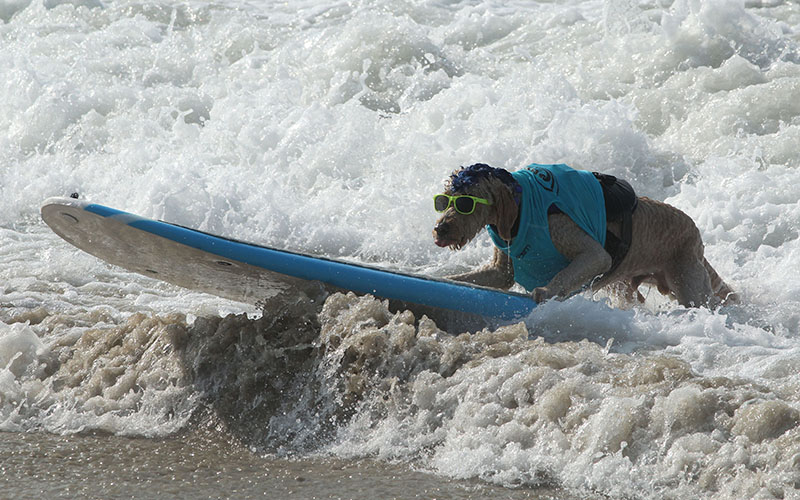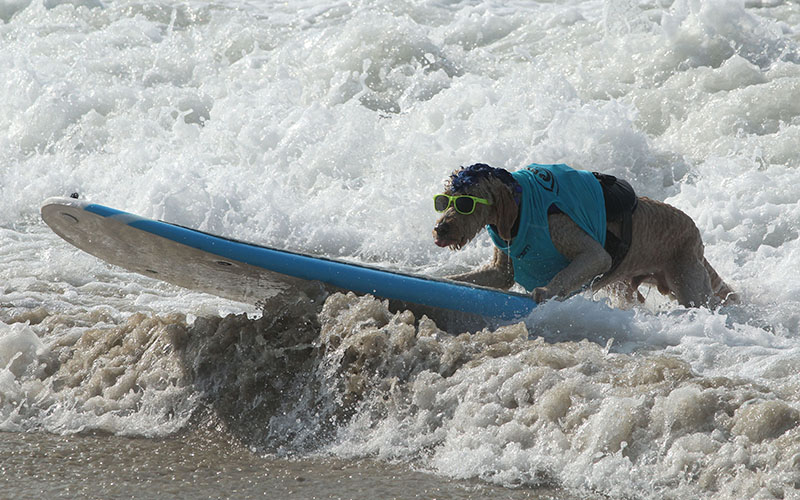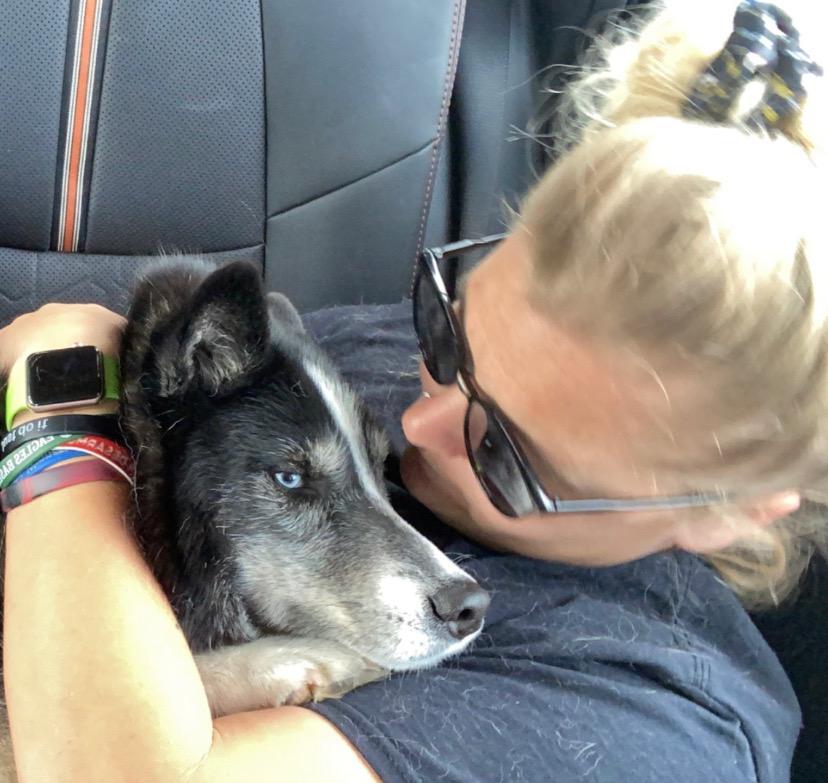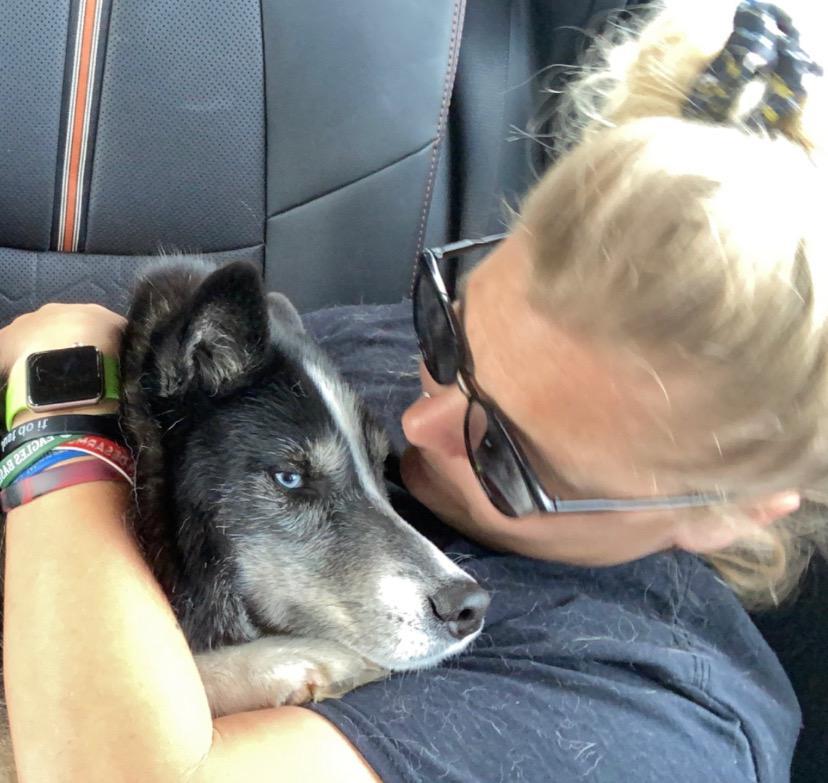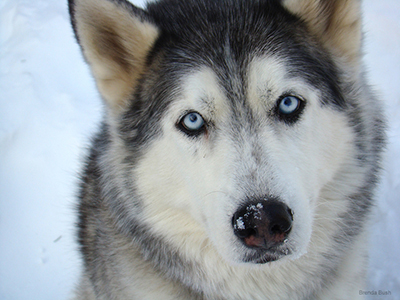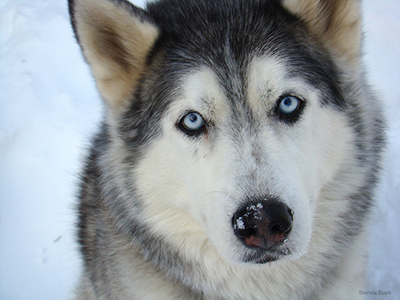
|
The movie 'Finch' explores how dogs help us define humanity
A furry friend, Goodyear the dog, makes a safe human home in the post-apocalyptic 'Finch.' (Apple TV+)
Warning: The following article contains spoilers about the movie ‘Finch’ The movie Finch, released in November on Apple TV+, stars Tom Hanks and a former rescue dog named Seamus. Critic Tomris Laffly, writing for Variety, describes it as a “big-hearted … post-apocalyptic saga.” Hanks plays the titular Finch, a survivor in a world with a failing ozone layer. Expecting he will soon die from the sun’s radiation, Finch builds Jeff, a hyper-intelligent robot voiced by Caleb Landry Jones, to care for his dog, Goodyear. Finch, like other science fiction stories featuring dogs, explores the human-dog relationship in part to define what it means to be human. Something revealed ‘between beings’ Over the course of my research on post-apocalyptic fiction — a sub-genre of science fiction that imagines the Earth as we know it coming to an end — I have been struck by how often dogs accompany the protagonists of such stories. Fiction like I Am Legend (1954) and A Boy and his Dog (1969), along with their respective film adaptations, are some relevant examples, as is the film The Road Warrior (1981) or the “Fallout” video game series. Many scholars writing on the topic of post-apocalyptic fiction suggest that one of the genre’s central preoccupations is the defining of humanity in relation to nature and to our place in the universe. Similarly, literature scholar Joan Gordon, who has researched science fiction related to animal studies, argues that the speculative capability of science fiction is well suited to explore the human-dog relationship as “a mutually influential feedback loop between beings, as they change and are changed by one another.” DOGS HELP MAKE A HOME Finch opens with Hanks’ character picking through an abandoned supermarket looking for food, and he just narrowly makes it home before being caught in a terrible storm. “Home” is an underground laboratory, but after descending the cold metallic staircase, Finch finds a warm welcome: a mat that reads “home sweet home” and a friendly dog who perks up at his master’s return. Just as pets in our own time can enhance their human owners’ health and well-being, Goodyear is able to relieve Finch of the mental distress brought on by apocalyptic social exclusion. As argued by the distinguished historian of utopia, Gregory Claeys, humanity’s fear of the dystopian “bad place” is partially inspired by our fear of the dangers lurking beyond the bounds of our societies. While dogs are not biologically human, Finch suggests they nonetheless assist in differentiating the safe human home from the dangerous outside world. DOGS AS COMPANIONS Goodyear functions much like the dog in The Last Man, one of the earliest examples of post-apocalyptic fiction by the 19th-century English Romantic novelist Mary Shelley. Shelley’s protagonist, Lionel Verney, ends the novel as a lonely survivor of a global cataclysm — in his case, a plague. Looking for companionship, Verney attempts to find sympathy among animals, but when a family of goats refuses to return his friendliness, he concedes that he “will not live among the wild scenes of nature.” But like Finch, Verney finds a companion in a dog: “[He] has never neglected to watch by and attend on me, shewing boisterous gratitude whenever I caressed or talked to him.” While the dog appears only briefly in Shelley’s novel, humanities scholar Hilary Strang suggests that its appearance introduces “a perverse kind of optimism in this rigorously pessimistic novel,” for “in the novel’s final moment, at least there is the possibility of more than one living, humanized creature surviving the future.” In both Finch and The Last Man, a line is drawn between the distinctly human realm and the realm of nature. And in both, dogs are on the side of humans. EMOTION AND CHARACTER As in other post-apocalyptic stories, Finch considers the nature of human character by exploring the emotional relationship between humans and dogs. Audience members are invited to reflect upon their own emotional response. For critic Bilge Ebiri, writing for Vulture, Hanks’ successful portrayal of “an ordinary man for extraordinary times” makes the “tear-jerking” Finch particularly effective. Hanks is able to play “a deeply human, relatable hero, suggesting that one needs not stoicism or expertise or muscles to succeed against insurmountable odds, but rather decency and vulnerability.” While Finch shows the positive side of human character, many dystopian works encourage their audience to reflect on their own emotions by depicting human beings acting inhumanely toward dogs. Contemporary science fiction author Paolo Bacigalupi, for instance, depicts curious yet callous bio-engineered soldiers abusing a dog in the short story “The People of Sand and Slag.” Similarly, Shelley’s contemporary Lord Byron took up this theme in his post-apocalyptic poem “Darkness.” Here, the mistreatment of a faithful dog serves to demonstrate the breakdown of human society. Byron and Bacigalupi, as well as Finch’s director, Miguel Sapochnik, all encourage their audiences to reflect on their empathetic reactions to human-dog relationships. TRUST AND BECOMING HUMAN The robot Jeff’s role in Finch is to gradually learn what it means to be human. The robot begins as a typically mechanical being but takes on more and more distinctly human traits as the film goes on. The final hurdle for Jeff to surpass is the gaining of Goodyear’s trust. Early in the film, Jeff tells Finch, “I don’t think it likes me.” Finch responds: “Well he doesn’t trust you.” During a game of fetch, Jeff throws the tennis ball but Goodyear keeps returning it to Finch. Jeff once again expresses disappointment, but Finch assures him that Goodyear will come around. “Trust me,” Finch says. As the film nears its end, we find Jeff mourning the death of Finch. Who should arrive just in time, wagging his tail and with a tennis ball in his mouth, but Goodyear looking for a game of fetch. Jeff raises his arms in excited triumph as Jeff runs to retrieve the ball. The film’s final message, then, is captured in a passage from W. Bruce Cameron’s book A Dog’s Journey (also made into a film) about a dog, reincarnated, who returns to find his master: “You can usually tell that a man is good if he has a dog who loves him.” *** I am a PhD candidate of English at Dalhousie University. I completed my MA in English from Dalhousie in 2018 and my MA in Philosophy from Brock University in 2014. This background in both English and Philosophy is supporting my current dissertation research, namely the relationship between post-apocalyptic/dystopian literature and utopian philosophy/politics. The opinions expressed are solely the author's and do not reflect the opinions and beliefs of the website or its affiliates. Republished under Creative Commons license. Originally published by The Conversation. Original article may be found by clicking here. Yes, your dog can understand what you're saying - to a point
Dogs can understand a range of human words. (Fabian Gieske/Unsplash), CC BY-SA
Humans are unique in their ability to develop sophisticated language abilities. Language allows us to communicate with each other and live in complex societies. It is key to our advanced cognitive abilities and technological prowess. As a developmental psychologist, I have extensively studied the role of language in children’s cognitive development, especially their executive functions – the cognitive skills that allow them to control their behaviour, plan for the future, solve difficult problems and resist temptation. EXECUTIVE FUNCTIONS The development of executive functions occurs slowly over the course of childhood. As they get older, children get better at organizing their thoughts and controlling their behaviours and emotions. In fact, humans are the only known species to develop advanced executive functions, although other species like birds, primates and dogs have rudimentary executive functions similar to young children. In humans, our ability to develop executive functions has been linked to our language development. Language permits us to form and hold representations of our goals and plans in mind, allowing us to govern our behaviour over the long term. What is not clear is whether language actually causes the emergence of executive functions, and whether the relation between language and executive functions exists only in humans. CANINE BEHAVIOUR For humans, studying dogs offers the perfect opportunity to consider these questions. First, dogs possess rudimentary executive functions. These can be measured in a variety of ways, including asking owners about their dogs’ ability to control their behaviours, as well as behavioural tests designed to assess dogs’ control abilities. Second, not only do we expose dogs regularly to human language, but research also indicates that dogs can perceive different words and can learn to respond to specific words. For example, three dogs — two border collies named Chaser and Rico, and a Yorkshire terrier named Bailey — learned to respond to over 1,000, 200 and 100 words, respectively. However, many dog language studies have been limited in scope, either examining the word-based responses of only one or a small sample of dogs, or the responses of multiple dogs but only to select words. One exception was a study in which 37 dog owners were asked to list words they believed their dogs responded to consistently. Owners reported that their dogs responded to an average of 29 words, although this likely is an underestimation. Indeed, research using a similar free-recall approach with parents shows that they are prone to forget many words when asked to generate lists of words to which their babies respond consistently. COMMUNICATING WITH DOGS Research with human infants does provide a solution for systematically and reliably assessing word-based responding in large samples of dogs. Arguably the best and most widely used measure of early language abilities of infants is the MacArthur-Bates Communicative Development Inventories, a parent-report checklist of words responded to consistently. Remarkably, the number of words selected on the MacArthur-Bates Communicative Development Inventory predicts children’s language development years later. In 2015, I began a collaboration with psychologist Catherine Reeve, at the time a graduate student working on dogs’ scent detection abilities. Our goal was to develop a similar measure of vocabulary for use with dog owners that we could then use to examine links between language and executive functions. We developed a list of 172 words organized in different categories (for example, toys, food, commands, outdoor places) and gave it to an online sample of 165 owners of family and professional dogs. We asked them to select words that their dogs responded to consistently. We found that, on average, service dogs respond to about 120 words, whereas family pets respond to about 80 words, ranging between 15 to 215 words across all dogs. We also found that certain breed groups, such as herding dogs like border collies and toy dogs like chihuahuas, respond to more words and phrases than other breed types like terriers, retrievers and mixed breeds. What we don’t yet know is whether dogs who respond to more words also have better executive functions. We recently assessed 100 dogs on a behavioural measure of executive functions and had their owners identify words on our vocabulary checklist. We are now analysing the results. I first became interested in studying dogs to see what they might tell us about child development. That said, this research might also provide important practical information about dogs. For example, it is very expensive to train puppies for service work and many do not make the final cut. However, if early word-based responding abilities predict later behavioural and cognitive abilities, our measure could become an early and simple tool to help predict which dogs are likely to become good service animals. *** I am an Associate Professor of Psychology and Neuroscience at Dalhousie University. I received my Bacholor?s degree from McGill University in Psychology, a Master?s and Ph.D from the University of Toronto in Developmental Psychology. I then did a 2-year postdoctoral fellowship at the Université de Montréal before coming to Dalhousie in 2003. The opinions expressed are solely the author's and do not reflect the opinions and beliefs of the website or its affiliates. Republished under Creative Commons license. Originally published by The Conversation. Original article may be found by clicking here. How the presence of pets builds trust among people
Pet ownership can often enhance feelings of trust among strangers. FOTOGRAFIA INC./Collections E+ via Getty Images
Companion animals are a core part of family life in the United States, with 90 million American households having at least one pet. Many of us view pets as beloved family members who provide nonjudgmental emotional support and companionship during times of stress. That’s not all. Research shows our pets can also strengthen our relationships and trust with other people. In addition, pets contribute positively to trust in our broader social communities. Companion animals as social facilitatorsAs many of us know, animals provide an avenue for approaching another person socially, serving as a conversational starting point for connection. Pet ownership alone could be a source of shared interest and knowledge, even among people who may not have similar interests otherwise. Simply walking down the street with a dog can lead to significantly more social interactions than walking without a dog. Assistance dogs can also facilitate these interactions. One study found that individuals using a wheelchair were more likely to be approached when their assistance animal was present. The presence of an animal can also enhance perceptions of trustworthiness and responsibility, which in turn fosters positive social interactions. Researchers found that people were more likely to help a stranger with a dog than one without a dog, suggesting that the presence of an animal conferred perceptions of trust. For children, interacting with a pet can also provide an additional opportunity to practice positive social interactions and develop empathy and compassion. Recent research indicates that living with dogs is associated with better social and emotional skills for children. In our own research at the Tufts Pets and Well-Being Lab, we also found that teenagers with high levels of attachment to their pets were likely to have higher levels of social skills and empathy toward others than those without such attachments. Pets and social capitalPets have also been shown to foster social capital in communities. Social capital is a concept that encompasses the broader community and neighborhood networks of social relationships, and the degree to which the community has a culture of helping others. The trust inherent in these connections can lead to better health and well-being. Interestingly, pet owners have consistently reported higher levels of social capital in their communities than people without pets, both in the United States and internationally. In addition to social facilitation, pets can contribute to social capital by strengthening social trust within communities. Neighbors may rely on one another to assist with animal care, which builds reciprocal trust. Pet owners’ use of shared spaces, such as dog parks or green spaces, can lead to better social relationships. In spite of it, during the COVID-19 pandemic dog owners were more likely than those without dogs to go for regular walks outdoors, providing an opportunity for community engagement during a period of extreme social isolation. The presence of an animal has even been found to increase positive social interactions in the workplace. While evidence continues to support the idea that pets foster positive interactions between people, animals are not a universal solution for creating trust. There is still a lot we need to learn about the interrelated relationships between pets and people. *** Dr. Megan Kiely Mueller is an Associate Professor of human-animal interaction at the Cummings School of Veterinary Medicine at Tufts University, and Co-Director of the Tufts Initiative for Human-Animal Interaction. She is also a senior fellow at the Jonathan M. Tisch College of Civic Life at Tufts University and teaches in the M.S. in Animals and Public Policy program at the Center for Animals and Public Policy. The opinions expressed are solely the author's and do not reflect the opinions and beliefs of the website or its affiliates. Republished under Creative Commons license. Originally published by The Conversation. Original article may be found by clicking here. Bella's Ordeal
She chewed off her leg in order to be free
Bella at Best Friends running on her remaining three legs.
August 16, 2021 was an eventful day in the life of Bella. Tied to a fence 24 hours a day the pit-bull mix was tired of life. So much that she decided it was better to cut off her own feet rather than live this way. Her owners, oblivious to her suffering, did not care one bit. So Bella had taken matters into her own hand by chewing off one of her feet in an attempt to free herself. Bleeding and seriously injured, she had laid down to die when a mail carrier noticed the suffering pup. He called Saginaw Animal Control and soon police showed up. Apparently Bella had been abandoned with no water or food, left to die a horrible death slowly. "This poor girl had to chew off her leg, but her personality is still so loving, even though she came in here starving, abandoned, and neglected," Bonnie Kanicki, the director of Saginaw County Animal Care and Control said shortly after taking Bella to the shelter. There they had to operate on her twice due to her injuries. Miraculously Bella adapted to her new facilities quickly and begun recovering. A testament to her courage and love in the face of incalculable human cruelty. But still Bella was not out of trouble as finding a good home for an injured, fearful dog on three legs was not an easy task. Stepped in Best Friends Animal Sanctuary, the largest no kill sanctuary in the United States. They reviewed the case of Bella and agreed to home her for as long as was necessary. Still Best Friends is located in Utah, Bella had to travel 1,800 miles from Saginaw, Michigan. Saginaw animal control officers Desi Sage who was the one that had responded to the original call from the letter carrier and Abbe Balderstone, another that helped in the rescue agreed to drive Bella the entire 1,800 miles. Bob and Pat Schust agreed to cover the costs of the trip as well and on Saturday, January 15th Bella started on her long journey home. Soon she was in Utah and in the warm and cuddly hands of animal loving people and volunteers at Best Friends. Her arrival was so enthusiastic that two of the founders of Best Friends were there to welcome her to the sanctuary. Now it's time for Bella to rest from the heinous life she has led so far. Rest, recover and be loved. Best Friends hopes to find a great home that will soon adopt Bella and bring her to her forever home. Humans are such a perplexing species. Capable of the greatest love and the most despicable acts possible, done almost simultaneously. This organization took a deep dive into the psychiatry and motives behind such inhumanity, titled An Anatomy of Cruelty, our conclusion may surprise many. Still we have the capability to rise above our instincts and do incredible things. The Saginaw Animal Control, the volunteers and Best Friends are all examples of that. The despicable human beings that left Bella to die will never be called to account for their actions. We can be better, we must be better. The opinions expressed are solely the author's and do not reflect the opinions and beliefs of the website or its affiliates. Dog Leads Police to Accident
Saves everyone's lives.
Tinsley leads police to the scene of the acciden.t Photograph: Richard Norris/Lebanon police department
Those old enough to remember Lassie will also recall how she seemed to know everything that was going on around her. She was in tune and often became integral in saving the lives of loved ones. At least that's what the scripted legendary show depicted. Last week in New Hampshire a real life Lassie episode unfolded. Cam Laundry, his friend Justin Connors and Laundry's dog Tinsley were driving at night along a country road when Cam lost control of the vehicle and hit the embankment hard, rolling the car over into a ditch. Justin was seriously injured and both of them were immobile. This is when Tinsley moved into action. Being aware of the acute condition of her owner she ran off. Ran off and stood in the middle of the road seemingly to flag down a car. Neighbors saw the dog and got worried that it would be run over and possibly cause an accident. “Of course we care about the dog. We don’t want to see it get injured, but it can also pose traffic hazards to motorists or pedestrians,” said Captain Tim Cohen of the Lebanon police department. “We wanted to make sure the dog didn’t cause an accident, especially on the interstate.” Said one onlooker that then dialed 911. The police arrived quickly and began chasing TInsley, "She wouldn’t really get near anybody,” followed Cohen. Thus ensued a chase for about 10 minutes, Tinsley running, then stopping, in order to allow the chasing police officers to catch up. Suddenly the police noticed they were near a broken embankment and looking further they saw a car completely destroyed and turned upside down. Upon further examination they found both Laundry and Connors alive, although severely hurt. A second dog, a bulldog was sadly thrown in the crash and was already dead. The Lebanon police chief, Phillip Roberts, said he had seen this behavior from police-trained dogs before, but never from a household pet. Laundry is back home now and Connors is recovering from leg and neck surgeries in hospital. Tinsley had played the part of Lassie, seeking help for her injured human companions and leading them to where they were lying. Stories like this are abound in the annals of the animals, particularly dogs. Only a select few ever see the public eye, but these living breathing creatures are there day and night watching over us as best they can. If only we humans had the capability to appreciate the precious gift given to us. “I want my friend Justin to get better as soon as possible. Things could’ve been a lot worse than they were,” Laundry said. “We’re very fortunate to be here today because of my friend, Tinsley.” The opinions expressed are solely the author's and do not reflect the opinions and beliefs of the website or its affiliates. The Love of an Elephant
And they say animals are just medium rare steak
Thomson calling his friends
When Darrick Thomson returned to Thailand after almost a year away in Cambodia, he was looking forward to reuniting with his family. And reunite he did in Chiang Mai, his family of elephants recognizing him standing in a river bed, thus beginning an emotional outreach, screaming along the way. They wanted to feel the warmth and touch of their friend, Thomson. You can watch the video that has mesmerized millions on Twitter below.
Darrick Thomson is not your ordinary fellow. He is a former firefighter from Toronto, Canada who a while back found a new love; animals; elephants to be specific. He calls them "angels of the forest". Thomson had gone to Cambodia to help with Kaavan the so called "world's loneliest elephant". Kaavan was isolated in the Islamabad Zoo with no space to roam. Once the story broke celebrities such as Cher got involved and made Kaavan a household name. Thomson was critical in creating a 30 acre habitat for Kaavan and to have transported her to the Cambodia Wildlife Sanctuary. She now roams happily with other elephants. His mission completed, Thomson returned to Thailand where he along with his wife, Lek Chailert, run the Cambodia Wildlife Sanctuary. The sanctuary, located at the Elephant Nature Park, is where 109 rescued elephants reside. Thomson describes the rescue facility as a “space for them to live and abide forever,” noting that it allows the elephants to rehabilitate and bond as friends and family. Upon his return to the sanctuary, Thomson stood in the shallow waters of a river stream and began yelling the names of the elephants. In the video the elephants recognize their friend from afar and begin screaming and charging toward him. As they approach him, the elephants surround the man seemingly in an embrace, ears flapping and trunks raised. Thomson in turn touches their trunks and strokes their bodies, at one point completely surrounded by the giant mammals. Watching the video you can almost feel love emanating from the screen. Why has this short clip captured the hearts of millions? Because human beings contain an intrinsic conflict in their lives. They love meat and are ready to accept the killing of animals, as long as they can imagine such animals to be nothing more than red protein. However, simultaneously, the subconscious logical part of our brain knows something is afoul in the paradigm. We instinctively know animals are more than just flesh. Everyone has watched a dog in his happiness as his owner approaches. But we are afraid to admit what we all know to be the truth, as the truth means sacrificing meat, something we all want to consume. When we see in live action love, caring, memory, endearment by animals it makes us emotional and simultaneously uncomfortable. This is the great conflict that is embedded in most humans alive today. Recognizing the truth yet refusing to affirm it. Elephants are indeed "angels of the forest" and sentient beings with all the emotions we humans covet for our own species. And as seen from the video, they know and feel love. One sunny day we will enshrine that love on to all the animals on Earth and the world will be as one again. The opinions expressed are solely the author's and do not reflect the opinions and beliefs of the website or its affiliates. One dog, two dogs, four dogs
A guide to integrating more than two dogs
If you are one of those people whose dream is to have more than 2 dogs and for them to all get along peacefully, then this article is for you. In my last article I listed some of the important guidelines I suggested you follow if you are looking to add a second dog to you household. All those are still applicable but if you are looking to add additional dogs, meaning you are looking to add a third, fourth, fifth etc., it is more complicated and involves additional guidelines. Here are some things you need to know.
I always recommend that, unless you are a season pack leader (and) is already diligent about supporting the existing hierarchy) that when looking to add a third, fourth or fifth dog to you pack that you hire a professional trainer or behavior consultant to help you. As my late Mom used to say “an ounce of prevention is worth a pound of cure.” This is money well spent and an investment in the smooth integration of your new, evolving pack. The more dogs you get the more complicated all this can become. It is a joy to have a larger, peaceful pack, so don’t be afraid to reach out for some professional guidance. Lastly, I always suggest that you never add 2 new dogs the same time. Let each new dog have time to integrate into the pack without the distraction of a second dog trying to fit in. This is especially important if you are looking at two dogs that already have a bond with each other. You want to set things up so that the new dog(s) are focused on you and not the other dog they already know. You MAY END UP WITH BOTH OF THESE DOGS BUT PLEASE TAKETHEM IN ONE AT A TIME/ Trust me, things always work out better that way. That being said, done correctly you can experience the joys of a large pack and avoid major issues that could have been avoided. *** Peggy Colonna is both a registered nurse as well as a certified obedience instructor. She specializes in solving problem pet behavior with the goal of keeping dogs out of the shelters and preventing them from being euthanized. A lifelong animal activist and prolific rescuer, Peggy brings to DogsInDanger the real world perspective of animal life is the US. The opinions expressed are solely the author's and do not reflect the opinions and beliefs of the website or its affiliates. Leonardo DiCaprio Becomes Superhero to Save His Dogs
The actor jumps into freezing water
He was filming "Don't Look Up" a film about a meteor disaster when real disaster struck Leonardo DiCaprio. He had just adopted two Siberian Huskies. The puppies can be a bundle as anyone that's been around Siberians knows well. In any case, DiCaprio decided to bring the pups with him to the shoot set in Boston. The puppies had never seen a frozen lake as they live in sunny southern California. One of them got a bit too curious and fell in the lake. The actor saw what happened and without a flinch jumped into the icy waters to save his dog. And save he did, but the second Husky now wanted in on the action, so he jumped into the lake as well, thinking this looked playful. Di Caprio swam and saved the second dog as well. Co actor Jenifer Lawrence said dad and dogs were cold but okay. “Well, the other one started licking the one that was drowning, and then we all were in the frozen lake together,” said DiCaprio. Just like the hero that saves his love in the blockbuster film Titanic, DiCaprio showed his humanity and selfless dedication by his courageous actions. DiCaprio and his girlfriend, Camila Morrone, have three Huskies. The two that he brought on set are Jack and Jill, who the couple adopted in 2020 after fostering them. DiCaprio in 2019 once again showed his real life hero credentials when he jumped into the water after a man that had fallen off a yacht. The man was about to drown when DiCaprio reached him and saved his life. The adventure in the frozen lake around Boston could have turned tragic as freezing temperature can affect one's physical and mental capabilities within seconds. Quickly muscles stop functioning and confusion begins. This is one of the reasons that only 706 of the Titanic's 3,300 passengers and crew survived. Most had jumped into the freezing waters to avert drowning and quickly perished. Kudos to Leonardo DiCaprio for being a hero in real life as well as on the silver screen. The opinions expressed are solely the author's and do not reflect the opinions and beliefs of the website or its affiliates. A Love that Spans the Centuries
Do you know anyone that receives gifts 100 years after death?
Rex in his final resting place with sticks left by residents
John Snow and his companion Rex were a pair. John was a kind hearted food seller. He worked hard and Rex was always with him, by his side, protecting him from harm and loving him. It was a difficult life in a difficult time but the pair were adored by the community because of their generosity and kindness. John Snow and Rex died over 100 years ago! Since no one alive today actually met or knew either of them the residents of the community have heard of their tales, handed down from grandparent to parent. Amazingly, people even today still leave sticks and small branches on the full size bronze statue of Rex that stands right next to John's burial ground in the Green-Wood Cemetery of Brooklyn, New York. The statue was erected by the locals as a tribute to Rex. The two thus were never separated by death, friends and companions forever. Rex was the “American Hachiko”, referring to the Japanese dog that returned to the train station where he met his owner for over nine years, after the latter's death. Waiting every day for his return. Townspeople that have lost their pets come to Rex’s grave, put sticks in his bronze paws, and ask him for a favor. To look after their loving missed pets until they meet them again! Sometimes humanity is able to rise above its destructive instincts and recognize the beauty that life can be. Love, friendship, loyalty are not only the domain of highly developed human beings, but also kind hearted cats and dogs. Our acceptance of this puts the entire race on a hopeful path to redemption and happiness. "The greatness of a nation and its moral progress can be judged by the way its animals are treated." Thank you John Snow and thank you Rex for bringing a bit of the best of humanity to our world. May the both of you rest in peace, together forever.
The opinions expressed are solely the author's and do not reflect the opinions and beliefs of the website or its affiliates. Thinking About Adding Another Dog To Your Existing Pack?
"how many dogs can you squeeze onto your couch?" by digitalshay
Regardless of whether or not you have one dog and want to add another, or have 2,3 4 etc. and want to add to your pack, it is important to choose the right dog to add. Here are some tips to ensure that you adopt a dog that is not only the right fit for you, but one that is also right for your existing pack members. One of the most pressing goals here is first to make the right choice so that the integration is a smooth and problem free. What follows are rules and recommendations that I learned when I went to college for animal behavior and canine training.
These are some of the guidelines that should be followed when looking for a second dog to add to your family. The more guidelines a person chooses to ignore, the more likely they will have problems peacefully integrating the new dog and the existing dog. Look for my next article on how to have a pack of 3 or more. In addition to the guidelines above there are other things one must take into consideration when wanting to have a large pack. Once you chose to go beyond 2 it is even more important to follow additional guidelines not mentions here. *** Peggy Colonna is both a registered nurse as well as a certified obedience instructor. She specializes in solving problem pet behavior with the goal of keeping dogs out of the shelters and preventing them from being euthanized. A lifelong animal activist and prolific rescuer, Peggy brings to DogsInDanger the real world perspective of animal life is the US. The opinions expressed are solely the author's and do not reflect the opinions and beliefs of the website or its affiliates. Arctic Fox Rescued From Iceberg
Fox caught on floating iceberg
As a 'make me feel good story', we want to tell you about the adventure Alan Russell, Mallory Harrigan and her boyfriend Cliff Russell had recently. They were fishing off the coast of William’s Harbor, Labrador, Canada when they saw a little moving thing on an adjacent small iceberg. They went in for a closer look at to heir amazement they discovered an arctic fox, somehow stuck on the isolated iceberg. There was nowhere for the fox to go on the tiny inlet and they all knew it would die a horrible death if they did not do something about it. They decided to try and save the wild animal. Alan drove the boat straight into the bottom of the iceberg and succeeded in collapsing it. Of course the fox then fell in the water. They then approached it with the boat and scooped him out with a dipnet. The creature was in a total mess and scared for his life, so they put Foxie (our name) in a container, just till he could feel safe and warm up a bit. Then the team returned ashore to a small uninhabited island full of little critters. Foxie soon revived, specially when he was given a treat of Vienna sausages. Video captured by the team shows the fox on the island, coming out of his cage and running away. Just before he disappears off the camera, Foxie stops on a ledge and turns around to look at his rescuers. He stands there for a minute, then turns and disappears. We'd like to think Foxie was expressing his gratitude to the boat crew for saving his life. The opinions expressed are solely the author's and do not reflect the opinions and beliefs of the website or its affiliates. Happy Tails for a Bait Dog
From abused and dying to loved forever
Lucky in her new home
On February 26, 2015, in the Chicago suburb of Lansing, animal control found a horribly abused dog in desperate need of help. She was emaciated, badly scarred both physically and mentally, and abandoned in a dirty cage. It was a dead-end street; it was snowing and cold. They could immediately tell she had been used as a bait dog, because of her wounds. What is a bait dog you might ask? The horrible answer is they are gentle dogs used as “practice” for fighting dogs to hurt another dog. It is a barbaric, and cruel way to treat animals, and many bait dogs often succumb to their wounds. This dog, however, did not, which is why she was likely abandoned on that cold, snowy day. She didn’t know it then, but her life was about to become magical and wonderful for the animal control took her to a nearby animal shelter, the South Suburban Humane Society. The South Suburban Humane Society was started in 1970 to take in unwanted animals and find them homes. Years later they expanded to include thrift shops to raise money to help adopt more animals into loving homes. The dog, whom the South Suburban Humane Society (SSHS) named Lefty, was terrified of people but the workers there were patient, taking great care to show her people can love, along with getting her healthy and helping her gain weight. One of the trainers, named Tony, really took a liking to her and worked with her often. She became important to the SSHS when they launched “Leftysjourney” on Facebook and YouTube discussing her journey from an abused bait dog to an adoptable family member. Trainers at the shelter worked with the dog they named Lefty to make her adoptable and not terrified of people. People started to hear about this wonderful dog and donated money for her care. It was just the beginning of her new journey as that May a couple came into the shelter to adopt. They were a couple who always loved dogs, and raised dogs (always shelter or rescues dogs, never bought) and were looking to add a new dog to the family. That couple was my parents and I learned from them that a dog means a forever responsibility. My parents never returned or rehomed a dog. They spent time with Lefty and decided to adopt this wonderful dog. She was renamed Lucky, because as my father often said, “she’s lucky we adopted her, and we are lucky she adopted us”. While she never got over her mistrust of many people was extremely attached to her family. One of her greatest moments was the following Christmas when she received several new toys and lots of chew bones. She was very spoiled and always expected to get her way and get what she wanted (which was usually always). In fact, the veterinarian warned my father about her weight because she went from the emaciated dying from starvation dog to a spoiled, chubby dog who ate snacks with her much loved human daddy. Sadly, all good things come to an end and Lucky’s story does as well. November 2020, she started to become sluggish, such as struggling to walk and eat. She was taken to the vet to see what the issue was, only to find out her heart was failing. The vet assumed it was due to her previous dog bait days but couldn’t be for sure. The decision was sad but the only choice and that was to be humanely “put to sleep”, only unlike millions of unwanted animals, she was surrounded by her family. I wish every dog had a second chance like Lucky, but if more people would adopt instead of shop, we would have more stories like hers. Rest in peace Lucky, and you will never be forgotten. *** Dawn has a Master of Arts Degree in Communications and a history of animal advocacy instilled in her by her parents. She has written extensively on animal subjects as well as for various media outlets and educational outlets. The opinions expressed are solely the author's and do not reflect the opinions and beliefs of the website or its affiliates. Picking The Right Dog for Your Family
"Shelter Dog" by Tobyotter
One of the saddest things I became aware of when I entered Mercy College’s canine training program in 1990 was the number of dogs returned to the shelter they were adopted from because they failed to meet the expectations of what the new owners expected a dog to be. Disappointing for the adopters but tragic for the poor dogs, who did nothing wrong but were just not the right fit for that particular family. The poor dogs, were just feeling safe and getting used to their new home, settling in and getting into a routine when they find themselves back in the cold, often noisy institutional environment of a shelter. Over the years this continues to pain me and seems so unnecessary. I always admire shelters and organizations that have a behavior consultant or trainer on hand dedicated to matching up dogs with owners. Life is not easy for volunteers, shelter staff and other workers dedicated to helping homeless animals. They are overworked, underpaid if paid at all and doing the best they can. This is not about blame. This article is about educating prospective adopters, shelter staff and other rescue groups looking for guidance, about how to ensure they find a match that turns into a forever home for a homeless dog. Some shelters and even some rescue groups do a better job than others of matching a dog’s drives and traits with the lifestyle of the prospective adopter. I sometimes chuckle when a person contacts me about one of my available rescues and say they want to adopt the dog because they just “LOVE the way that dog looks.” I wonder how many human marriages end in divorce because after the initial physical attractions cools off a bit the partners realize they have nothing at all in common. I always will remember the adult sister of someone who had sought me out to help her and her family years back get the right dog for them. The adult sister was single, lived and worked in Manhattan, was a jogger and generally jogged 5 miles a day, sometimes more on her days off from work/. She wanted a dog to run with. She adopted a very sweet middle age, low energy dog because she was attracted to the dog’s appearance. The problem was that the dog was more of a couch potato than a runner and she ended up returning to dog to the shelter. It was after that that she first contacted me. I went to meet her in her tiny NYHC apartment and could see immediately that her own energy level was very high and that a dog that would meet her expectations needed to be a younger, physically active dog. I had a beautiful young male APBT that LOVED to exercise and run. It seemed like a match made in Heaven. This woman talked fast, moved fast and thrived on being on the go. This young boy that I adopted out to her fit the bill and became her daily jogging partner and beloved companion.. I showed her how to keep the dog mentally exercised while she was a work with interactive dog toys so that the dog got both the physical and mental exercise her needed be content and fulfilled. I never forgot however the dog that she returned and only imagined how sad he was to be back in a shelter environment. Our local shelter once called and asked me to meet a family at the shelter that was very interested in this one particular dog. They were not sure if this was a good match or not. When I met the family and asked about their leisure activities, lifestyle, etc it seemed to me that they needed a dog that had a lower energy level and that would be content laying by someone’s feet while that person read the newspaper. The dog they were attracted to was very high energy. After I talked to them, about the disparity in their energy levels I asked them to take a look at a few dogs that I thought they would be happier with. They initially balked but when I took several dogs that I thought were more suitable, out of their shelter runs separately and each interacted with the family, I could see the light bulb go off in their heads. We then had all those lower energy dogs back in their respective runs and brought out the dog they initially wanted. After the dog jumped all over them and ran around the “meet and greet pen” frenetically, I suggested they take that dog for a walk. They made their own decision that this dog would likely be too much for them to handle and actually left with a dog that I felt confident would be their forever dog. My recommendations are as follows:
I used to laugh when clients would call very small dogs “ankle biters” but if the dog is young and nippy, the ankles are the easiest place to reach on a human. In addition think before adopting as to whether you want a dog that requires professional grooming on a regular basic. If anyone in the household is allergic that are several hypoallergenic breeds such as Soft Coated Wheaten Terrier, poodles, and many others to choose from. Do your research before adopting your dog. When in doubt meet with a trainer or behavior consultant who can go with you to assess the dog you are looking at. They are great resources for helping ensure you get a dog that is a great match for you and your family. They may charge a small fee but trust me, it is money well spent. *** Peggy Colonna is both a registered nurse as well as a certified obedience instructor. She specializes in solving problem pet behavior with the goal of keeping dogs out of the shelters and preventing them from being euthanized. A lifelong animal activist and prolific rescuer, Peggy brings to DogsInDanger the real world perspective of animal life is the US. The opinions expressed are solely the author's and do not reflect the opinions and beliefs of the website or its affiliates. Puppy Tales
Bundled Came the Stranger
On February 3, 1999, the 40th anniversary of “the day the music died,” I had to put down my almost 15-year-old Samoyed, Gulliver. It was personally devastating. I worked another twenty-six days at my teaching job and retired. Meanwhile, “conventional wisdom” offered me three basic choices: get another puppy right away; wait a decent interval to respect Gulliver’s memory, or foster pets to share the joys without the commitment. So, almost by accident, I came upon a pet adoption site while out driving and went in to bring some smiles to the puppies. Eventually, I was introduced to Holly, a lively little springer spaniel who was lined up for a permanent home in Connecticut. But she needed a foster parent for the weekend, and I volunteered. I loaded the car up with Holly, dog food, and toys, and I doubt that I’ve ever, before or after, seen a dog so happy. She was going to a real home! She went from the back set to the front set with ease, and I thought she would sit on my head if I allowed her. Not a good idea on the highway. We got ‘home’ and I took her out to my fenced back yard and she absolutely loved the idea of running around, but she constantly came back to me and we’d try a new corner of the property. After a good hour of that, it was time for rest, and I guided Holly into the family room, put up a ‘pretend-gate’ to keep her in, and I stretched out on the couch while she lay down maybe ten feet away. I fell asleep, but when I woke up, I found a gently sleeping little dog nestled on my left arm and shoulder area. Sleeping like a baby! I knew I had a friend, but I knew she would be leaving for a new home. I’d been told she liked to sleep on a towel or near leather, so, hours later, I took her out and then up to the bedroom where I spread out a towel alongside my leather briefcase. Wearing her bandana, she made herself very comfortable. I woke up at 5 a.m. with a dog sleeping on my left side, exactly like the afternoon. We went outside, then back upstairs, but this time, when I put her down on her towel and I got in bed, she marched over, climbed up the bed frame and nestled on my arm. That went on for another day and a half, and I reminded myself how unconditionally dogs can share affection. Holly was so happy and so well behaved…. But, the time came to take her back so she could go to her rescue home, and it was not at all easy to say goodbye to Holly. I later learned that she was doing wonderfully in her new home in Connecticut, and that went a long way to defusing the rash I’d gotten on my left side from her sleeping on me. That was 1999. I still think about Holly often, and even though we only had three days, she is as strong and wonderful a memory as I have for the six wonderful dogs who have been with me at different times since 1969. Foster. Rescue. There are millions of Hollys waiting for love. The opinions expressed are solely the author's and do not reflect the opinions and beliefs of the website or its affiliates. Sniffing out the waves: Doggy surfing contest brings smiles to spectators
Surfs Up!
Derby the goldendoodle was one of the most stylish dogs out there, rocking a blue mohawk and sunglasses at the Surf City Surf Dog competition in Huntington Beach on Saturday.
The winners of the Surf City Surf Dog contest were clear: Everyone who was on a board or watching from the beach. For five hours on Saturday, Sept. 25, a few hundred– two- and four-legged alike – came to watch from the beach a mile north of the U.S. Open for Surfing. Rather than doggy-paddling out into position, participating pooches were put on boards and towed out by owners and volunteers to catch the next wave. “It’s the smiles that matter,” said Donald Horn, the owner of two surfing Cavalier King Charles spaniels, Samson and Delilah. “If you look at the beach today, everybody is smiling, and that’s because we all love our dogs.” Over the past 12 years, more than 500 dogs have ridden the waves along the famous Surf City coast in these events. More than two dozen canine surfers were judged by professional surfers, and the scores were based on the length of the wave, confidence of ride and the difficulty of the wave and other factors. The event included other attractions for dogs and the people who love them, such as canine play zones and pet adoptions. The field was divided by weight classes, with the smallest dogs going first. From West Highland terriers to miniature pinschers, the pooches rode the waves with surprising control of the big surfboards. As the tide rolled in later in the day, bigger dogs hit the surf. The tide brought bigger waves, which made things a little hairy for many of the dogs. After the solo competition came the “double dog” heat, which was dominated by the goldendoodle duo of Derby and Teddy. Daniel Royce is the owner of Teddy the goldendoodle, and the two started surfing because of Teddy’s affinity for the water. “He’s barking, yelling the whole way out until he gets on the board,” Royce said. “I don’t have to put him on the board, he just jumps on.” The day ended with dog/human tandems before each pooch received a participation medal and the top dogs won trophies. Horn and his spaniels have surfed competitively for nine years. Samson, white with black spots, rides backwards at the back of the surfboard and Delilah, white with brown spots, works the front. Both also competed in the small dog heats. Like any owner, Horn has a lot of love for his dogs. He choked up at times talking about how much they have meant to him on their journey to discover dog surfing. “(Samson) always liked the ocean,” Horn said. “When he was about 5, we saw some videos of dog surfing. I thought, ‘I wonder if Sammy would do that.’” Samson interjected with emphatic barks of affirmation during Horn’s retelling of the story. “So I bought a cheap board, took Sammy to the beach and stuck him on, and his first three waves rode them all the way to the beach,” Horn said. “I thought I had a winner. “Everybody wants their dog to win, but the dogs don’t give a darn who wins. Even though we’re all competitive and we want our dogs to win, that doesn’t stop us from helping the person we’re competing with. That’s what it’s all about.” This day meant a lot to Horn and his dogs. Samson, 14, officially retired after Saturday’s event. Delilah, 11, still has some competitive surfing years left in her. “It’s emotional,” Horn said. “It isn’t going to be his last ride. He just loves it so much.” The two will still surf together outside competition just for fun, but as Horn pointed out, it was never about competition for the dog, it was just about the fun. “That’s what it’s all about,” Royce said. “Putting on a show and having fun.” *** David Rodish expects to graduate in 2023 with a degree in sports journalism. Rodish, who has covered sports and politics for The State Press, is working in the LA Sports Bureau. The opinions expressed are solely the author's and do not reflect the opinions and beliefs of the website or its affiliates. Republished under Creative Commons license. Originally published by The Cronkite News. Original article may be found by clicking here. Lost pet network finds Garden City dog 300 miles away
Ready for some good news? This is Ashley's story.
Ashley With Brittany Novickis
If she were asked to list one of the worst days of her life, Brittney Novickis likely would say March 7, 2020, the day her beloved husky, Ashley, disappeared. Hands down one of Novickis’ best days would be March 22, Sunday, the day she got a telephone call from Daytona Beach, Florida, saying that Ashley had been found. How the dog ended up nearly 300 miles away from Novickis’ Garden City home is a complete mystery. But Novickis and her fiancé Paul McCarthy are only grateful and relieved that Ashley was found. She credits social media and the help of caring friends and strangers for a happy ending to a sad story. As soon as she got word that Ashley was missing, Novickis began scouring her neighborhood calling for the dog and looking everywhere. “I was out walking until 2 a.m. looking for her,” she recalled. “It was awful.” On that fateful day, both Novickis and McCarthy were working. She was in Rincon and he was across town in Savannah. They figured that the dog sitter left the door open around 2 p.m. and Ashley wandered away. McCarthy came home around 7 p.m. and saw that the door was ajar. He immediately began trying to reach his bride-to-be. He and Novickis adopted Ashley five years ago he knew it was going to be a challenge to find her because the dog had a huge head start. Novickis had been giving softball lessons and hadn’t checked her cell phone. ″(McCarthy) had called me about 57 times,” she explained. A former college softball player, Novickis came to Savannah to enroll at Savannah College of Art & Design where she earned a master’s in painting. After discovering that she “really missed softball,” she started offering lessons, fell in love with her students and their parents and decided to make softball a career. “I can’t even call it a job because I love it so much.” She has her own business called A2B Mechanics and averages working with 100 athletes a week. She travels to nearby counties and into South Carolina to teach softball mechanics. She often takes Ashley to the lessons. Ashley is one of four dogs owned by Novickis and McCarthy. For a long time, they only had Ashley and Mavis, who began grieving soon after Ashley disappeared. “She stopped eating and laid by the door,” Novickis said of Mavis, who is a Labrador rescue. (Their other two dogs are Banner and Rae Belle.) Immediately, Novickis posted Ashley’s picture and information on various Facebook lost and found pages. As the days and weeks dragged on, Novickis continued with her Facebook comments. On March 20, she wrote: “I just can’t help thinking where she is and what she’s doing. If someone has her I hope you’re taking care of her and giving her the love she had in our home.” Novickis and McCarthy regularly canvassed their neighborhood and talked to both the Garden City Police and truck drivers passing through the nearby port. The couple, as well as softball parents and players in other counties, put up fliers and spread the word on Facebook. Friends of friends shared the post and put the information on numerous lost and found pages. Meanwhile, the young couple was baffled that nobody had even spotted Ashley. It was almost as if the dog had disappeared into thin air. (The couple theorizes that Ashley must have gotten picked up by a concerned truck driver who saw her on the loose. Ashley then may have escaped from the truck driver around Daytona.) On March 22, Novickis received a call from Hailey Lingo, a Daytona Beach pet advocate who regularly checks Facebook’s lost and found pages. “I have my own pet sitting business and I’m big in the fostering community,” Lingo explained, adding that she has two rescue dogs of her own. “I had just gotten off the Halifax (County) Humane Society Facebook page and then read about Ashley on a lost and found page out of south Georgia,” she recalled. “I said, ‘hey that looks like a dog I just saw on the humane society page.’” Lingo reached out to Novickis and told her she thought the dog was Ashley. Novickis, in turn, called the humane society in Daytona and explained the situation to the person who answered the phone. The woman told Novickis that the dog had been found nearby without a collar, was turned into them on March 13 and listed as a stray. (Ashley was wearing a collar and tags the day she disappeared.) “I asked her to go back to the dog and say ‘Ashley’ and tell her to sit and speak,” said Novickis, who was put on hold for what seemed like forever. The worker finally returned to the phone and told Novickis that she approached the kennel and said five or six names before saying Ashley. When she did the dog recognized its name and started jumping up and down. Novickis couldn’t believe what she was hearing. She and McCarthy gathered Ashley’s veterinarian records and jumped in the car to drive to Daytona. When they arrived, they were led to the kennel. “I was so excited. I knew it was her instantly,” Novickis said. “I saw her goofy little grin and just knew.” The heartwarming reunion was filmed by humane society personnel, shared on its Facebook page and went viral with than 500,000 views. Novickis and McCarthy couldn’t be happier. “We are thrilled,” she said. And what would she tell other pet owners whose fur babies are missing? “I prayed,” she said. Don’t give up hope and keep sharing (on social media). Let people help you and, overall, just don’t give up.” To view the reunion video go to facebook.com (@halifaxhumanesociety). *** Polly Powers Stramm is a contributing lifestyles columnist for the Savannah Morning News. The opinions expressed are solely the author's and do not reflect the opinions and beliefs of the website or its affiliates. Republished under Creative Commons license. Originally published by Savannah Morning News. Original article may be found by clicking here. Collateral Love
Sometimes we make decisions that irrevocably change our lives.
Vila
Warm doggie breath and two big blue eyes greet me as I awake at 6:00AM. As my beloved furkid, Vila, gently rests her chin on the bed and looks lovingly into my eyes, it's hard for me to remember that this is the same dog that has driven me to tears and complete frustration so many times. Sometimes we make decisions that irrevocably change our lives. Already with two young active dogs at home, I certainly didn't need another dog. Two dogs should be enough for anyone, and indeed it was. But I was committed to fostering for a local Siberian Husky rescue group, and a vacancy at home meant one more life could be saved. It wasn't long after my foster dog Iciss was adopted that I was searching for another dog to foster. On September 4, 2004 I drove to the city animal shelter to find a dog that needed a second chance at life. I brought home an 11-month-old, black and white, blue eyed Siberian Husky, Vila. I still remember that fateful day at the shelter, choosing between Vila and another dog to be my next foster dog. It felt like Sophie's Choice. Vila was seized from neglectful owners. Due to her circumstances, she was deemed more urgent, and so I chose Vila to come home with me. Little did I know at the time, that decision would change everything for me, and for Vila. Being part of a homeless dog's journey to a loving forever home is a privilege and a blessing that is immeasurable. Finding the strength to let them go after investing your heart and soul in them is only possible by focusing on the next dog that will be saved. Those who foster understand all too well that it is a huge personal commitment which can be a rewarding experience or a disastrous one. It can change your life, forever. Vila is one of those 'once-in-a-lifetime' dogs that forced me to trade in my warm fuzzy view of dogs. She came to me a high anxiety girl with a truck load of issues --separation anxiety, resource guarding, housebreaking issues, and undersocialization. She had no idea what was expected of her or where she fit into the world. She had no self control and no bounds to her behavior. Transitioning to a new home is stressful for any dog. Certain undesirable behaviors are expected. Well, I got it all, and them some, with Vila. The first few months with Vila were hell. With no inhibition about bathroom duties, she spent the first three months confined to the room with me or leashed to me. With lots of treats and praise, she gradually learned that outside is where she is expected to go. (Funny, now she is the most assuredly housebroken of the bunch.) She paced, drooled, and panted through the first weeks but we survived. She was stressed and confused. She bullied the other dogs and would guard the water bowl from anywhere in the house. She screamed torturous screams every time I left her. I had bruises and scratches up and down both arms and legs from her anxiety and displaced frustration after being left alone. She destroyed a storm door and chewed the moulding of several windows. She feared everything new and trusted no one. I used every behavior modification and positive training technique I knew. I worked with a trainer on her dog-dog and resource guarding issues. When I picked her up from the spay/neuter clinic, the vet's note on her record read 'Needs training and socialization.' Yeah doc, no kidding! In rescue, she earned the nickname 'Vila-monster'. Two years in rescue went by and Vila was still with me. Adoption after adoption was just not the right match. As anyone in rescue knows, there are lots of dogs like Vila in need of that adult only, dog savvy home. Vila has never bitten anyone, but she's one of those dogs who requires a high level of management, commitment and awareness. At each potential adoption I worried, Would she forgive me for abandoning her? Would they be able to manage her issues? Would they fail her and return her to me even more damaged than before? I took responsibility for her life the day I picked her up and that responsibility weighed heavily on me. As a foster home, I tried to remain open to considering the right home for Vila if it came along. After all, the goal of fostering is not to help one dog, but rather to help many over time. In the end, I could not bear the thought of asking this high anxiety girl to give up everything she had learned to trust and understand as home, to transition to yet another home. In the process of working through these tough issues together, something else happened. Vila worked her way right into my heart. We had become so attached to each other. It would break my heart to part with her. I don't know where this journey will take us, but I know we are meant to travel it together. There are many paths through life. Our dogs can and do serve as our teachers. They offer us lessons if we open our hearts to hear them. I taught Vila to trust. She taught me that no tool can subdue adversity more effectively than humor and playfulness, and that unconditional love comes in many forms. From Vila I also learned that what we long for is not necessarily what we get, at least not without having to learn some hard lessons along the way. With love and patience, Vila blossomed. She approaches each day with unending curiosity and playfulness. Simple pleasures light her entire being with joy. She reminds me every day that life is precious and brief, full of fleeting joys and missed opportunities. For all of her problems, she is boundless in her loyalty and love. Love and dedication healed much of what had been askew, though not all that is broken can be put right. Vila is still a high anxiety girl and will always be a work in progress. Every time she lays down, she sighes the most dramatic sigh, like she has the weight of the world on her shoulders. But I grew to love this crazy dog, in spite of everything, or perhaps because of everything. On hindsight, it is clear to me that a dog like Vila never would have survived the shelter. Few adopters choose to take on a dog like Vila, rather one goes into such a relationship unknowingly and over time the dog captures your heart. And so it was with Vila and me. Life with Vila has consequences, for sure. I knew that by adopting Vila and taking on dog number three, I had reached my personal limit of dogs and my days of fostering were over. To some it may not seem significant, but foster homes are a precious rare commodity and choosing to adopt one's foster dog is bittersweet. For that's many more dogs that will not get a second chance at life. The decision to give up fostering came with a heavy heart. I also knew that in so many ways my life would be dictated by the choice to keep this challenging dog. I knew that in sparing both of us the heartache of losing each other, that I was trading away something unknown but also immeasurable. My heart told me that I needed to make that trade. *** Brenda Bush is Co-Founder of DogsInDanger.com and serves as Vice-President and Board Member of The Buddy Fund. She left a successful career in the legal profession to fuel her passion for saving animals. She is an advocate and activist on many issues relating to animal rights and welfare. She has been instrumental in many causes and campaigns for companion animals, farm animals and wildlife. She has been featured in multiple media outlets including The Today Show, BBC and CNN, among many others. The opinions expressed are solely the author's and do not reflect the opinions and beliefs of the website or its affiliates. |


